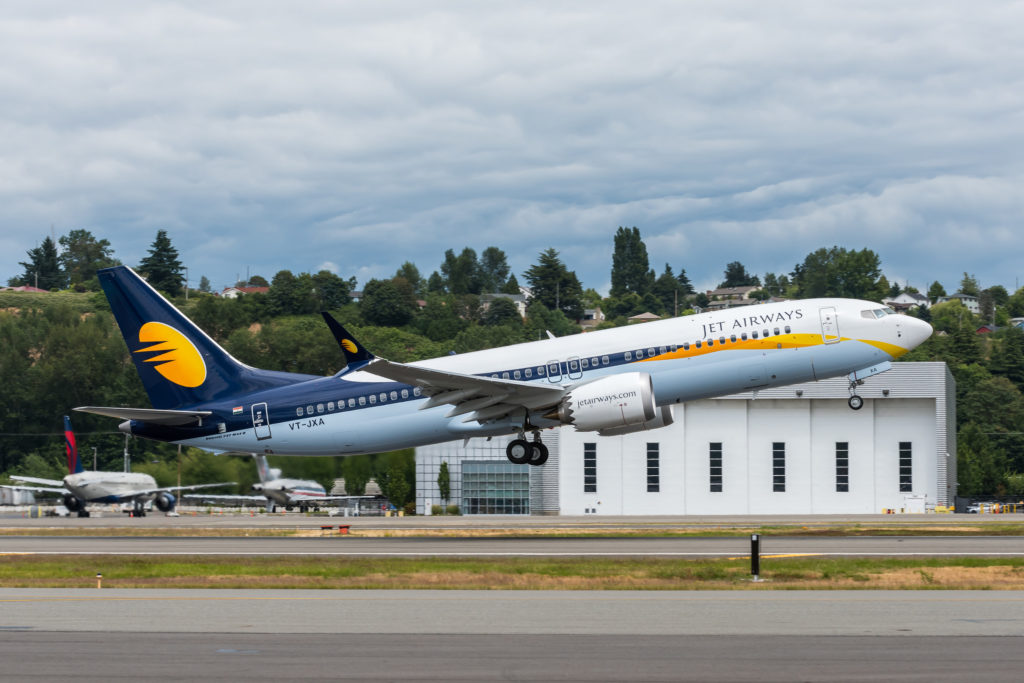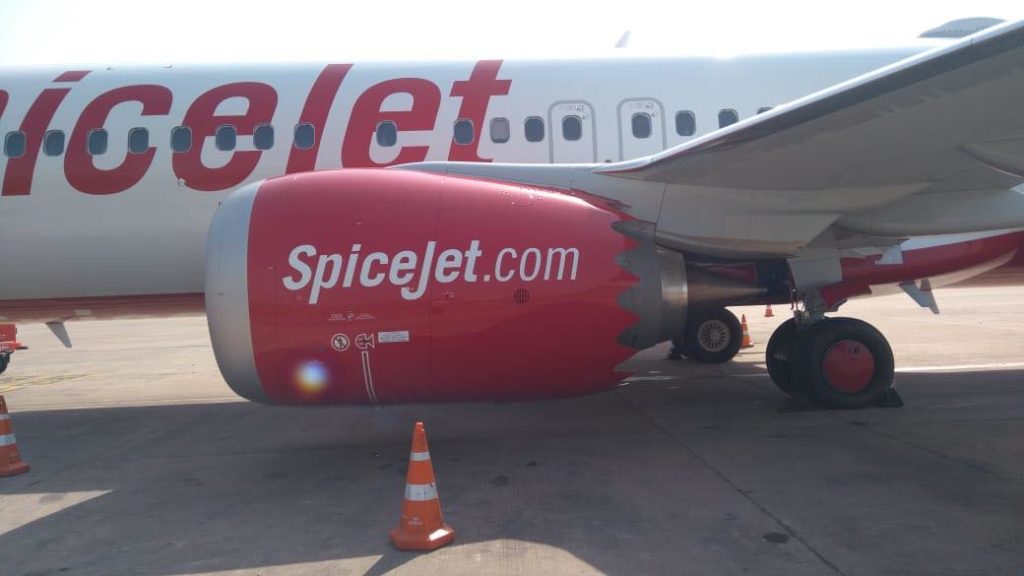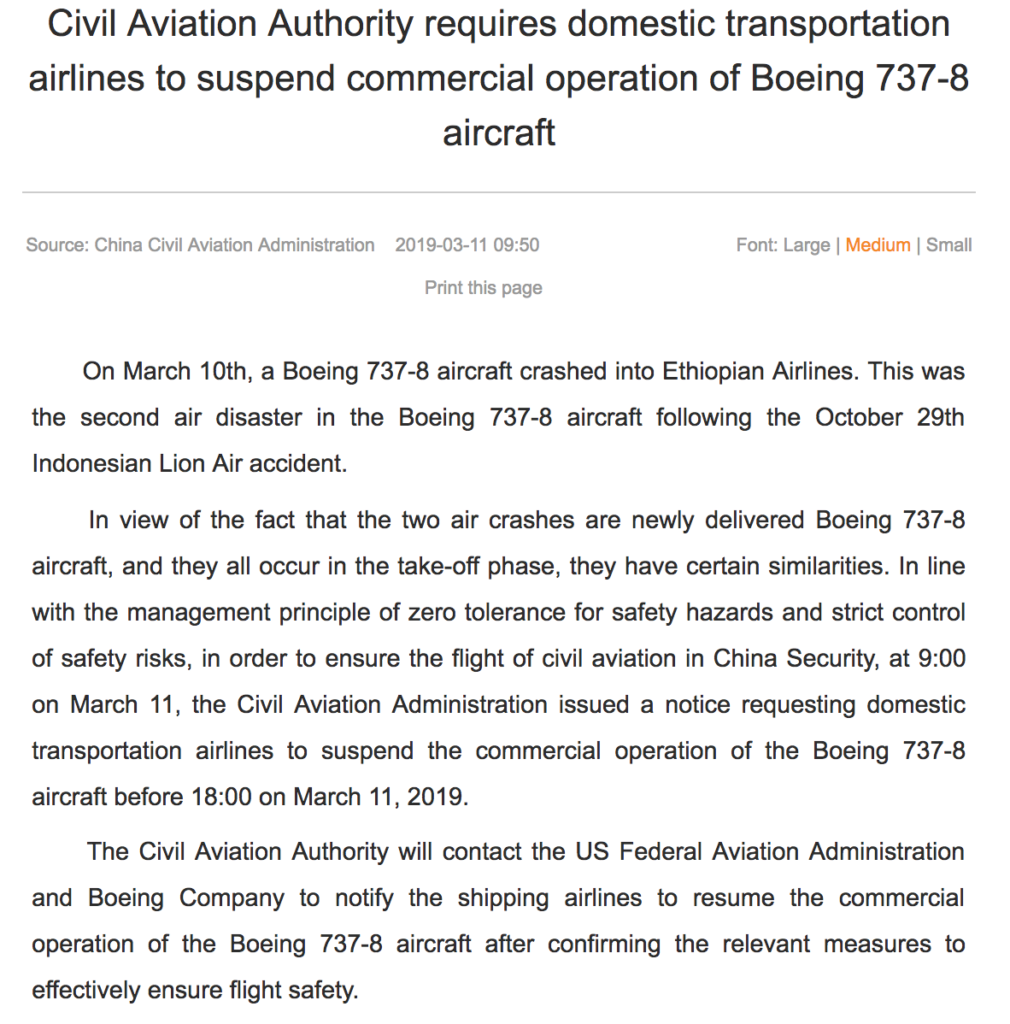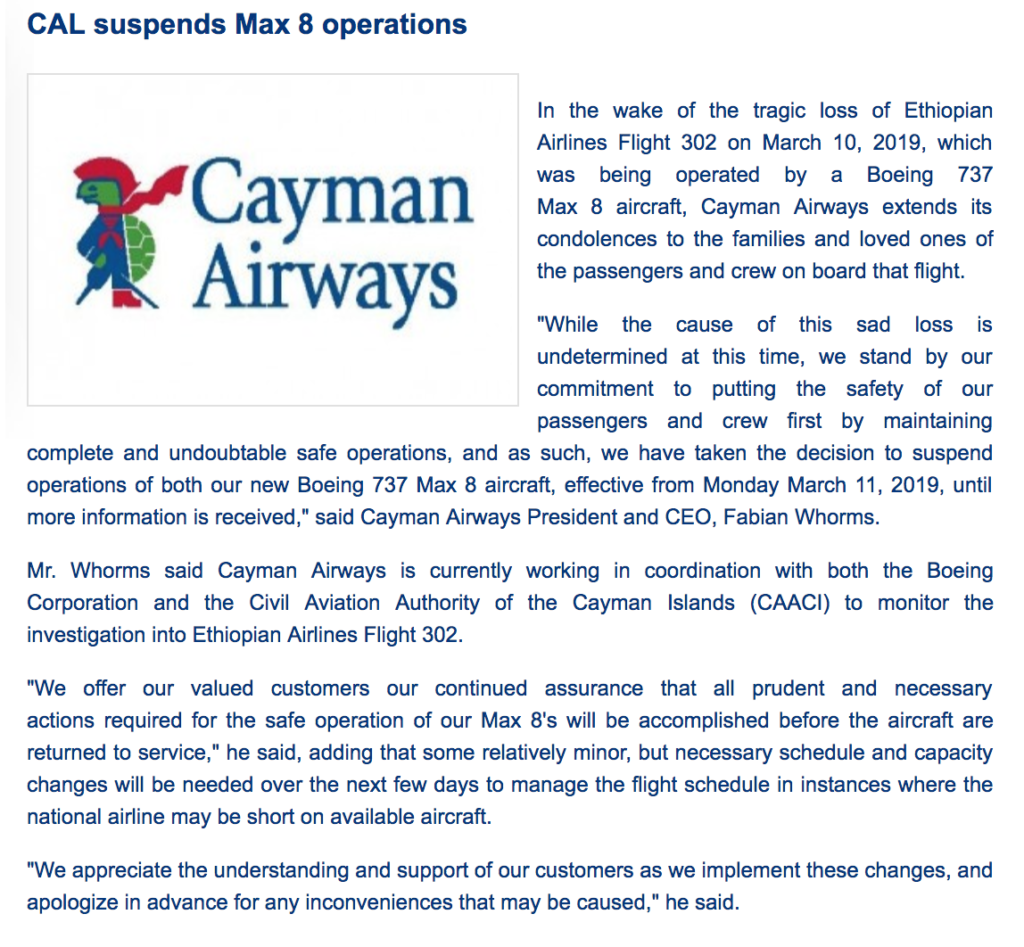Just yesterday, Ethiopian Airlines had an unfortunate crash of a Boeing 737 MAX 8 aircraft, shortly after takeoff from Addis Ababa, on its way to Nairobi. 157 people lost their lives, including 149 passengers and 8 crew in this tragic incident. This comes very close after Lion Air had a similar incident about 5 months ago, where another Boeing 737 MAX 8 aircraft crashed as well.
Now, I know that there is a huge amount of correlation between the nature of the two incidents, and the fact that both occurred on practically brand new aircraft. But the first piece of advice I’ve been giving everyone is not to speculate. In the times of social media, everyone becomes an expert on every issue, but that, unfortunately, is not the solution to our problems.
The Boeing 737 MAX is a redesigned version of the Boeing 737, which is the workhorse of many airlines globally. Over 10,000 Boeing 737 aircraft fly around the globe, and the aircraft has had a successful safety record.
The new aircraft, the Boeing 737 MAX, entered service in 2017. With newer technologies and design specs, and more fuel-efficient design, the aircraft could go further and spend less fuel while getting there. Which, in airline economics means, the path to the profitability of an airline/route. At the moment 350 of these aircraft are in service, with over 5,000 Boeing 737 MAX aircraft on order.
In India, SpiceJet and Jet Airways are the two Boeing customers for the 737 MAX range. SpiceJet has 205 on order, including their options, and Jet Airways has 225 on order.

First delivery of 737 MAX to Jet Airways.
It is very easy to spot the 737 MAX aircraft. If you are scheduled to fly one, you should see 7M8 as the equipment code for the 737 MAX 8. Or if you can’t find your equipment code, just look out for the engine cowling, which is serrated, so you are looking for a pattern like this below, which won’t be found on the older 737 aircraft lines.

Should the 737 MAX be grounded?


Accident Bulletin no. 5 Issued on March 11, 2019 at 07:08 AM Local Time pic.twitter.com/rwxa51Fgij
— Ethiopian Airlines (@flyethiopian) March 11, 2019
But, on the other hand, Southwest, which is one of the larger operators of the plane type, has placed confidence in the aircraft and are not allowing customers to change flights for free.
We remain confident in the Safety of our fleet of more than 750 Boeing aircraft and currently have a fleet of 34 Boeing 737 MAX 8 aircraft on property. -Nicole
— Southwest Airlines (@SouthwestAir) March 11, 2019
So what will Indian airlines do? In the case of Jet Airways, the 5 MAX aircraft they have are already grounded due to their lessor troubles. SpiceJet, the other 737 MAX operator from India, continues to use the aircraft, and has not issued any statement about their plans with the MAX 8 fleet for the moment.
I don’t expect the Indian regulator DGCA to be able to take the hard call to ground the plane type as a whole, given how they operated when the A320neo issues happened. The political reasons for not doing this, I will let you infer for yourself.
What should you do?
It depends on how confident you feel. Personally, if I was to fly a MAX, I would still do it. Aviation is much much safer than walking on the road and getting hit by a truck. But if you feel uncomfortable flying the MAX, you should look at switching to flights which are not operated by the MAX aircraft. However do not expect a waiver from SpiceJet on this count.
Bottomline
It is sad that we’ve had two 737 MAX airframes crashing in close proximity of each other. Hopefully, Boeing would be able to quickly determine the cause of the issue with the support of FAA, NTSB and other investigating authorities soon, and address any issues or gaps quickly. Or perhaps, this is all just a bad coincidence. We don’t know. But we need to know, as quickly as possible.
What do you feel about the current situation with the Boeing 737 MAX aircraft? What would you do if you had to fly one of these?


I don’t fly, I know it’s supposed to be the safest and the best way to travel, The only way I’m going to fly is when they get a skyhook, would you like a safety line, so I’ll probably never go overseas in that case. If I can’t put one foot on the ground, I Ain’t going.
Let the investigation complete. We should not jump on conclusion. Wait and watch.
Second crash had witnesses reporting smoke, clothing and papers exiting the aircraft before the crash. There is no software issue that could cause the kind of structural failure this implies.
It’s surprising that no one looks at the story from a pilots viewpoint! If the aircraft was not safe do you think the pilots would sign off to fly these aircraft’s? If u add up The total flights of all max 8 aircraft and pilots hours one would get an answer. I think if there was something wrong the pilots would be the first one to stop flying! So I wouldn’t think too much and if a pilot is comfortable flying an aircraft I will go with him.. After all he is the one most important for your safety at that moment any way!!
That’s a terrible argument.
Pilots have to do a job, and the odds are still low a particular plane will crash, if your safety policy is to wait for pilots to refuse to fly a plane they are told to fly, think it through a couple minutes and then decide if it’s a good policy.
Second, pilots (like all of us) are vulnerable to “it won’t happen to me” mentality as well as bias. The odds of any individual 737Max crashing are still low, a bunch have already been flying around. The question is whether those odds are low enough, and for this type of question you need statistics and expertise, not what pilots feel (which you don’t even know; 737Max pilots that feel pressure to keep flying, may well feel otherwise, but since the odds remain low they may see it as a reasonable career move to not make waves; i.e. your assumption is baseless to begin with, and even if the assumption is true your argument isn’t sound).
Sorry didn’t see the pilot’s sign off to fly it right before impact.
If your arguments stands there will be no broken down cars, ever.
This article thoroughly discusses Boeing’s new MCAS system on the Max. Caution reading it is hazardous to ignorance.
https://theaircurrent.com/aviation-safety/what-is-the-boeing-737-max-maneuvering-characteristics-augmentation-system-mcas-jt610/
Flying on 737 M 8 tonight from Hyderabad to Singapore (MI 473).
My thoughts are very simple on this, don’t fly on Boeing 737 MAX.
Exactly, Europe skies are now forbidden to 737 Max 8 & 9, if it’s a Boeing I’m not flying.
Airbus A320 Neo rules!
Due to fly on a max8 on25march. Tui seem happy for my wife and i to get on board a potential flying coffin. Is there no limit to commercial greed?
Brand New Air-planes falling from Sky within a span of Months..at what point Boeing will
acknowledge the issue. Seems like this might be cover-up for a underlying Design flaw.
Here’s a serious question. If the first flight crash had been a flight taking off from LAX, most passengers middle class Americans, would there have been a second crash to report? Plenty of high profile westerners on the second one. This is as much about news values as safety.
Is this specifically the 737 MAX 8? What about 9?
Flight tomorrow no 7M9. Should I be concerned?
I would introduce myself to the pilots as you enter the plane and say: “I trust you more than the plane; please keep ‘M-CAS’ off”. This is one of the planes internal control systems they believe might be the culprit.
“At the moment 350 of these aircraft are in service”
Well, 348 actually.
Lion Air Flight 610 (Oct.29 2018)
——————————————-
Brand new aircraft–737Max8
Computers of the airplane took control
Pilots could not gain manual control; only seconds were available
The craft gained tremendous speed at nose-down position
It crashed in the ocean at a very high speed
Ethiopian Airlines Flight 302 (10th Mar 2019)
————————————————————
Brand new aircraft–737Max8
The detail of the behaviour of the craft prior to the crash has not been known yet
It is reported that some locals had observed smoke from the tail and swerving of the aircraft, before it crashed
So, unless it is sabotage of some kind, the coincidence should not be ignored.
Will I fly in 737Max in near future? I will not, unless I have no other choice.
The reporting describes “white smoke”. When was the last time you saw white smoke? I suggest it was a vapor of some sort: water, hydraulic fluid or AC refrigerant.
Predictable response from most commentators and Airlines, Profits are more important than peoples lives.
Anyone with half a brain can see there is problem with the equipment.
“Profits are more important than peoples lives.” This is not a profits vs. safety issue because the problem has not been shown to be common on the aircraft. Please note that airlines must always fly aircraft that are not as safe as, say, staying in one’s house. Perfect safety is not common in our risk-laden lives. However, each person can weigh these risks and choose to fly or not fly on the airlines that are choosing to continue 737 flights. I am quite sure that pilots and airlines around the world will be paying close attention to ensure high safety for their customers.
Typical throw a bunch of fallacies at anyone challenging your core beliefs.
This is a profits vs safety. There’s two crashes in 5 months, basic common sense is to ground the aircraft. That doesn’t mean ground all aircraft and never fly again, it means ground this particular aircraft. Is there definitive proof there’s faulty equipment or UX design? Could the 737Max be just as safe, or the safest, and it’s just a random fluke that two incompetent pilots and/or improbable scenarios that have nothing to do with the aircraft happened to crash 2 737Max within 5 months? Yes, it’s possible it’s a random fluke and investigation will demonstrate that. But the law of averages says it’s probably not random, it’s probably this aircraft is more dangerous. Safety is about playing probabilities. Yes, flying anything has some inherent risk that the user accepts, but that does not imply a flyer should therefore step on any plane. There’s statistical evidence that this plane is more dangerous than others, therefore it’s safer to fly on other planes. This is why many countries have ordered grounding and no-fly-through of the 737Max, because there’s actionable evidence it’s less safe than other planes not just because they felt like it or their aviation authorities suddenly developed an irrational fear of flying.
It’s simply common sense to ground the plane. At the moment we don’t know exactly what happened. So it could be the plane and if another plane crashed while we were “waiting to be sure the plane has a flaw” heads would roll (think about it, no one would accept “but they didn’t know yet” as an excuse if there’s a third accident pending the investigation). Indeed, it’s not even a big disruption and cost to flyers, as there’s not many of the 737Maxes flying at the moment. Indeed, poll the flyers who had travels disrupted by the plane ground: there’s just been a crash, I’m willing to bet most flyers who got rerouted were/are happy about it. So it’s easy and a pretty trivial cost to rerout flyers. The groundings only do significant inconvenience to Boeing’s stock as it demonstrates aviation authorities aren’t as stupid as Boeing and the US would like nor feel they need to follow US lead anyway (hint: that’s bad for business generally).
Using your logic, why wouldn’t you ground the airline that had the crash?
The disturbing common factor in both accidents is that in each case, I believe the pilots were unable to determine their altitude due to what they described as instrument malfunction. Boeing’s bandaid of down powering a runaway horizontal stabilizer trim condition does not address the pilots’ reporting to ATC the flight instrument problems. This runaway trim can last for 10 seconds duration and repeat after 5 seconds. Imagine the confusion trying to sort out and handle this with several aural and voice warnings sounding.
Boeing Bandaid instructions:
Initially, higher control forces may be needed to overcome any stabilizer nose down trim already applied. Electric stabilizer trim can be used to neutralize control column pitch forces before moving the STAB TRIM CUTOUT switches to CUTOUT. Manual stabilizer trim can be used after the STAB TRIM CUTOUT switches are moved to CUTOUT.
This seems like a software problem. I’m a pilot but rather ignorant.
Good article with Emergency Airworthiness Directive issued by Boeing after the Lyon Air accident.
https://airwaysmag.com/industry/lion-air-crash-boeing-warns-737-max-operators-of-potential-trim-fault/
“I’m a pilot but rather ignorant.”
At least you added that disclaimer after you speculated—incorrectly—on the cause of the crashes. That’s more than the mainstream media have done, abandoning all semblance of ethics in their rampsnt speculation, creating a story that grew wilder by the day. Four months before you made your comment, the preliminary accident report on Lion Air was released. It behooves you to read it, it shows how the penultimate flight—which was the first flight after the sensor was replaced—made it to its destination even though it experienced exactly the same conditions as the next flight and the Ethiopian flight that crashed. Combine that info with the later revelation (the voice recorder was recovered almost two months after that preliminary report was issued) that on LNI043 the pilots didn’t know how to turn off the stab trim system either—a pilot from Batik Air (a subsidiary of Lion Air) who happened to be sitting in the cockpit because he was deadheading, had to show them what to do. The media has studiously avoided focusing on that flight. Why? Because it shows quite clearly that the effects of a bad AoA sensor can be handled quite easily by properly trained 737NG pilots, without any knowledge of MCAS or any MAX-specific training… EXACTLY as Boeing expected and predicted. The keywords are “properly trained.” Dig into the Appendices of that report and you’ll find that the airplane did NOT have the same AoA problem persistently for two days before the crash. The faults listed in the maintenance log are not the symptoms of a bad AoA sensor (compare with Boeing’s list of AoA symptoms), nor did those faults appear persistently for two days. The media mistook those log entries to be a list of all flights made by that airplane, but in fact it made quite a few more that don’t show on the list because the faults were cleared before the flight and no faults appeared during the flight. But all the symptoms listed by Boeing for a bad AoA sensor appeared after the sensor was replaced, i.e. maintenance removed a good sensor and installed a bad one.
What is so tricky? You want one more MAX 8 to fall off the sky killing another 150 innocent lives to ground these flying coffins?
There are commercial reasons for Boeing to not issue an advisory to ground the MAX 8, its all double standards if an incident of this nature have occurred in the US/EU the FAA would have taken drastic steps. Just because it has happened in Ethiopia and Indonesia nothing is being done.
Being an aviation blogger on whom many common people rely for genuine airline news you should be open about it and call a spade a spade instead of keeping your commercial interests ahead and not calling for the grounding of this aircraft.
The more planes fly more people will fly which will benefit you as more things to blog about!
@SS, don’t you think if I really wanted to favour an airline or an aircraft, I could have just not written anything and ignored the subject. My job is to present facts, not speculate. I will let the investigation officers come to the conclusions.
Thanks. I am content to suspend judgment until after the experts have had time to thoroughly investigate.
“Angle of Attack sensor”. These are being used in cars today to control and correct the transmission and engine speed. I had a brand new Chevrolet truck that would not function correctly around corners, uphill, or downhill. GM was the largest company in the world in the 80’s, but they can’t solve the angle of a vehicle problem with their sensors.
Even if the airline pilot has an override it is electronic, not an analog toggle switch, on-off. How often do you touch an electronic input on your phone, or laptop, and it does not function immediately. Right. Sometimes they stall, or think for a few seconds.
At 5,000 feet on take-off, five seconds wait time for response is the problem with the system 737 Max.
Do you even know what Angle of Attack is? Or how the sensor to measure it works? After you find out, perhaps you’ll see how absurd is your statement attributing your truck’s problems to an angle of attack sensor and why it would be useless and silly to put an AoA sensor on a truck which in normal operation has all wheels firmly planted on the road.
Seems like a similar problem, although I agree nobody should speculate. But from what I read the pilots did want to return right after take off. Their vertical velocity was unusual and low, probably pointing to similar equipment issues as Lion Air and pilot compensating for the faulty MCAS and whatever sensors help it. Or worse, not knowing how to stop it. But from what we know, all pointers are to the wrong nose elevation, and pilots being unhappy.
If a single point failure of a sensor (in this case one AoA sensor) can trigger a sudden nose-down trim of an aircraft at any altitude that’s surely a staggering design flaw. Boeing can issue whatever amendments to the pilot’s manuals they wish, but there will be always a pilot who would fail to manually recover an aircraft from such a prevailing situation. So yes, more 737M8’s might crash in the future, especially in the tropics, where such errors are more likely to happen. Unless, of course, the whole control system is redesigned. I would advise anyone to stop thinking of flying 737M8s! This situation is in a completely different league than the ongoing troubles with PW1000G.
Actually, the single point of failure problem is not new at all. There have been a bunch of crashes in the past where the angle of attack sensor simply froze and gave wrong readings, and by the time the pilots realised it was too late. Here, the problem seems with the new system called MCAS. We don’t know exactly if it’s pilot training regarding it or the system itself or if it’s prone to a certain reoccurring real-world edge case not known yet. So not fair to speculate.
But angle of attack sensor has been a single point of failure multiple times before.
MCAS is nothing but a version of autopilot meant to automatically correct severe stall situations. Such systems are not new even in commercial airplanes. In fact, military airplanes have a suite of such control systems in place as they normally have relaxed static stability. In this case, the MCAS seems to get activated by a single AoA sensor’s (erroneous) reading, which is neither cross-validated with a second AoA sensor reading (that is also available) nor the pilot is forewarned about a possible issue. If adequate such feedback loops were in place the pilots don’t really need to be exposed to the working of MCAS, as Boeing may have thought.
Btw, that’s how “single point of failure” is defined in contrast to multiple points of failure where more than one such sensors may fail (which is less likely). Any control system (read MCAS) that is designed around such a single point of failure system is still a staggering design flaw!
Interesting comment.
Why would a pilot fail to recover from a stab trim runaway condition?
What error is more likely to happen in the tropics and why?
Kudos to China & the airlines for taking the right step. High time authorities in India did the same. I am definitely putting my Oman Air plans on hold , considering they fly the same aircraft to Delhi. This is definitely not a coincidence & Boeing should stop passing the buck.
I am not aware that Boeing is “passing the buck.” To the contrary, it is taking very rapid and intensive action to learn all it can of the accident. It will also be aware of ongoing federal actions to determine causes and culpability.
All that Boeing did after the Lion Air crash , was to blame the pilots for not being aware of checklists , procedures , etc. And why wouldn’t they , after all it’s a matter of losing billions in lawsuits. Influencing pilot associations like those of Southwest to speak in their favour , further shows how low big corporate giants can stoop. We are just pawns for some people who will continue to fly in their well checked & maintaned private jets , least cared about a commercial jet crashing in Asia or Africa. God forbid if such a thing had happened in the west initially , the lives of the Ethiopian Airlines passengers might have been saved.
Hi Ajay,
Very well written and detailed information shared by you. I expect the authorities and DGCA to take appropriate measures so the we people should be assured of safety before taking such flights.
If it’s a Boeing 737 MAX, I aint going … until after a full comprehensive investigation as to the root causes is done and appropriate solutions are implemented.